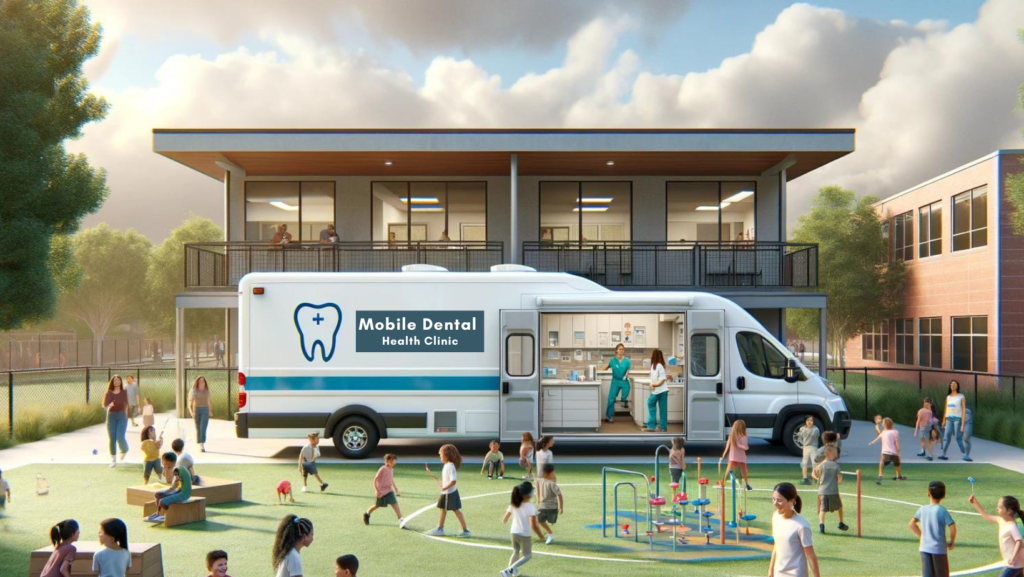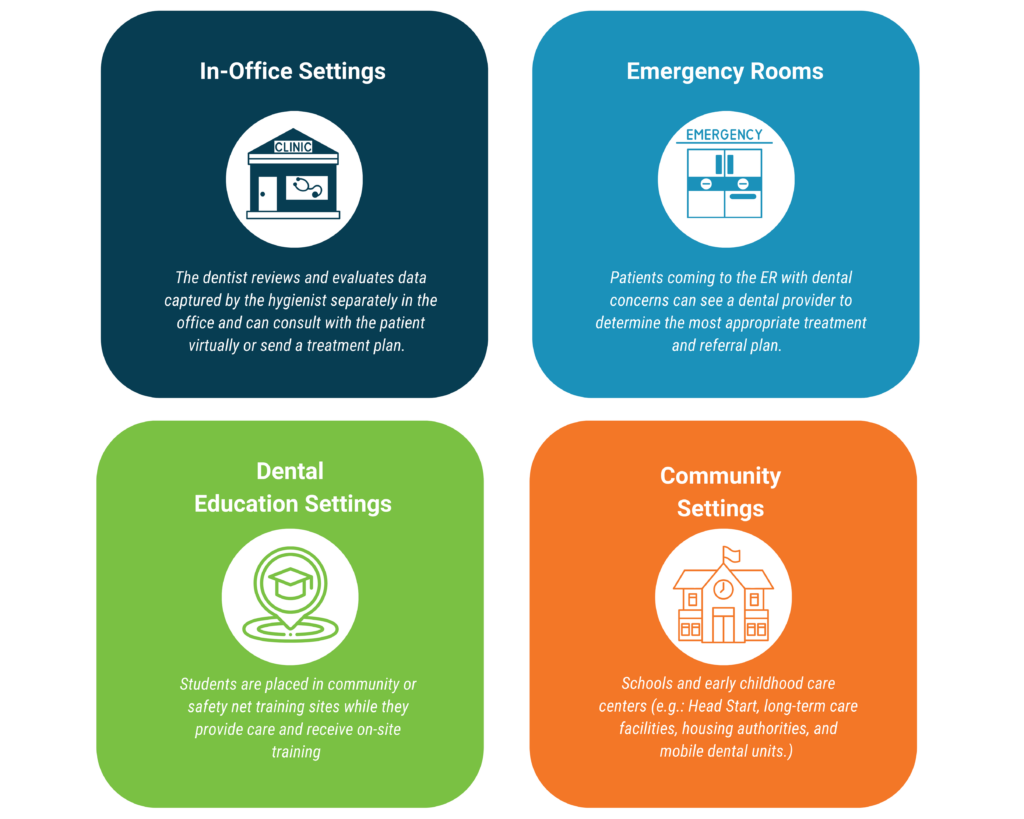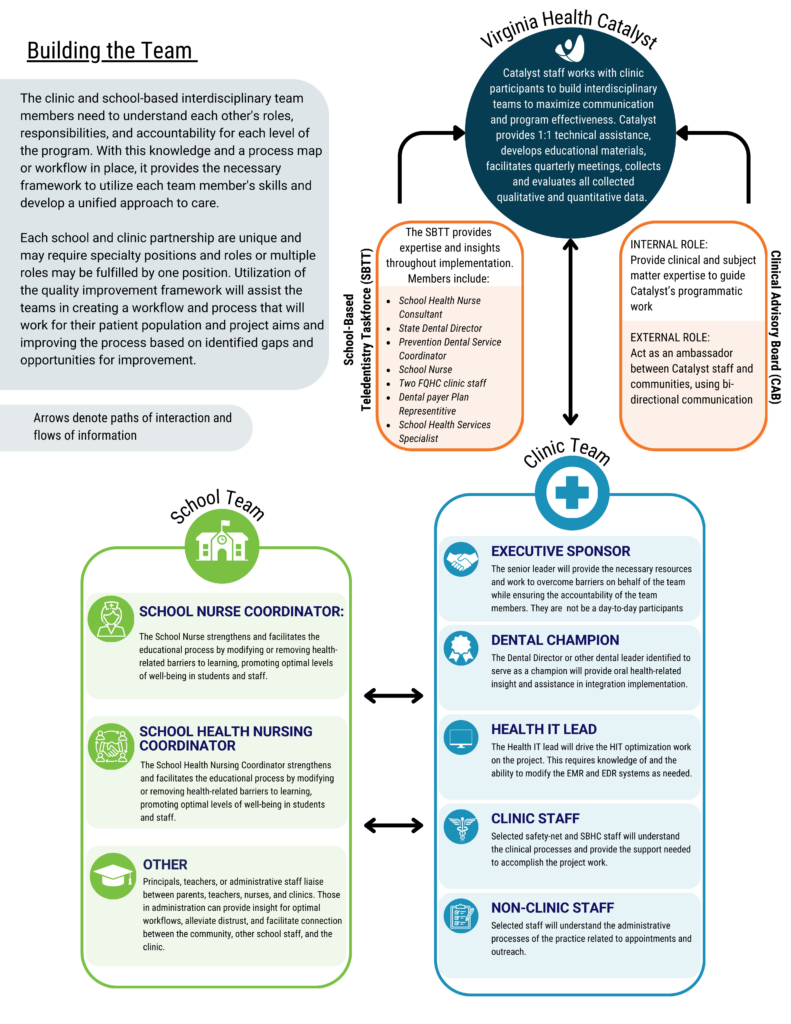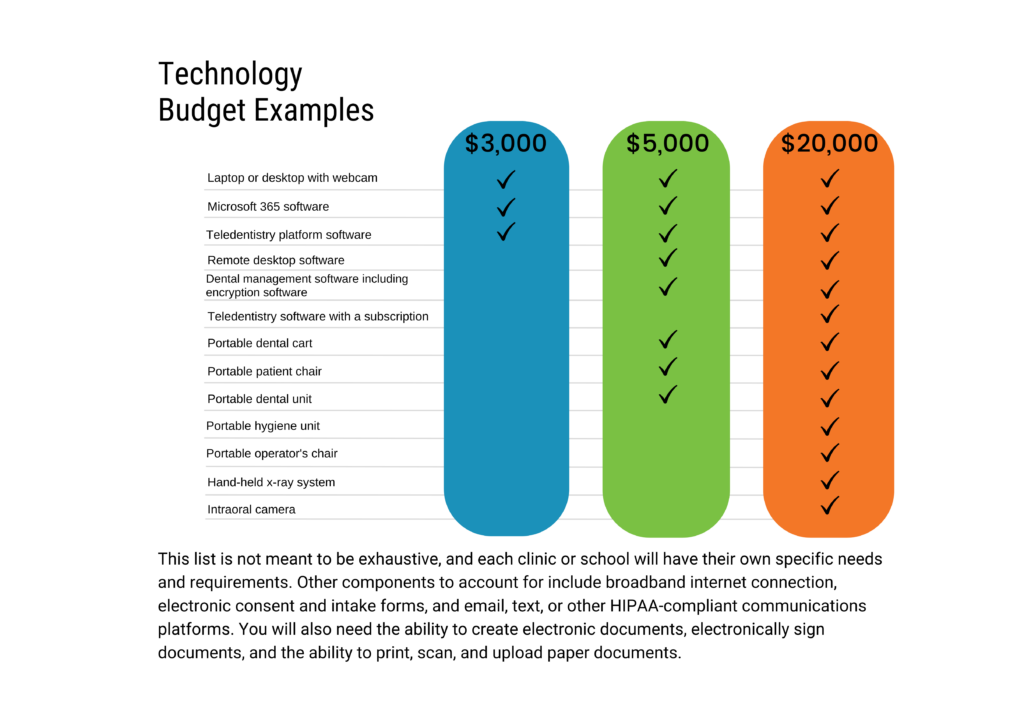Program Models
Click the below icons to read more about each topic

Teledentistry, as a subset of telemedicine, utilizes technology for managing dental consultations, remote supervision, dental hygiene, and dental emergencies. The American Dental Association explains that teledentistry can include, but is not limited to, synchronous and asynchronous care, remote patient monitoring, and mobile health. This technology offers the ability to provide one-on-one patient education without leaving their home or school. Increasing the public’s awareness and acceptance of care through a digital process will help decrease barriers and improve equitable access to care. For the school population, learning to utilize teledentistry can benefit students receiving care in a timely fashion and enhance the student’s ability to be healthy.
Selecting Delivery Methods
Asynchronous: Utilizing asynchronous technology, digital images and notes can be transmitted using technology for the provider to review later (American Dental Association, 2023). For instance, hygienists can perform oral hygiene appointments without the dentist being present by utilizing remote supervision. Once the hygiene appointment is complete, they can store and forward the information to the provider for review and treatment planning. Asynchronous teledentistry offers provider flexibility and increases access to dental care. The supplies to use this technology consist of an intraoral camera, laptop computer, mobile chairs for the provider, staff, and patient, and a portable dental unit containing air, water, suction, and drainage.
Synchronous: Utilizing synchronous teledentistry, providers use audiovisual telecommunications to facilitate real-time interaction between the oral health provider and the patient (American Dental Association, 2023). Synchronous teledentistry offers face-to-face patient interaction, encouraging patient-provider relationships without patients leaving their homes and schools. The downside of any teledentistry visit is that an oral health provider cannot physically examine a patient during a synchronous visit, which is a limitation. The supplies for this technology consist of a computer with a webcam and microphone, an intraoral camera or smartphone, internet access, and a subscription to a communication platform.
Ensure that your platform is HIPAA compliant for patient privacy.
Mobile teledentistry is employed when delivering or receiving dental care using portable dental equipment and mobile dental vans. Any dental service, whether comprehensive or preventive, that occurs outside of a brick-and-mortar building is considered mobile dentistry. Mobile teledentistry brings your dental services to your patients. The cost of this technology is more extensive than synchronous and asynchronous and can be a limiting factor. A mode of transportation (e.g., van), laptop, intraoral camera, portable x-ray unit with sensor, portable dental unit, and mobile chairs are required.
Types of Settings
Distant Site
A site where a health care provider is located while providing services via a telecommunications system.
Originating Site
A site where a patient is located at the time health care services are provided via a telecommunications system or the site from which the patient’s health information is transmitted for an asynchronous store and forward service.

Building the Team
The visual below outlines the partnerships and stakeholders involved in Virginia Health Catalysts’ School-Based Teledentistry program. The partnership between each clinic, school, and/or technical assistance team will look different based on each group’s physical, social, and cultural differences.

Technology Budgets

- Teledentistry Guide to Understanding and Documenting Teledentistry Events (ADA, updated 1/2023) The use of D9995 and D9996 and their distinctions can be challenging for those new to the teledentistry world. The ADA guide provides questions, scenarios, and appendices for insight to providers and reporting their care
- Guidance Document for Patient Assessment via Synchronous Teledentistry (Mouthwatch) The guide provides consideration for both patients and providers on how to set up their materials and exam workflow to ensure a successful and positive teledentistry experience.
- Patient Assessment via Synchronous Teledentistry: Clinical Techniques Overview with Dr. Scott Howell (Webinar) The video webinar accompanies the above guideline produced by MouthWatch.
- Teledentistry and Mobile Dentistry: A Perfect Match (Mouthwatch) The use of teledentistry alongside mobile dentistry offers a promising method to expand patient reach and capacity for long-standing mobile endeavors
- Motivational interviewing for the dental team teledentistry, for all of its benefits, can have drawbacks when connecting with patients due to the separation of a screen. Motivational interviewing is one tool you can use to connect with your patients and ensure a higher success rate for oral health goals.
- Teledentistry Platform options Catalyst, Created March 2020 The options around teledentistry platforms continue to expand as more providers utilize forms of telehealth. Here’s a list of just a few that oral health providers can utilize, with the understanding that each clinic will have unique needs for their choice of platform.
- HIPAA, FERPA, and School Health: Confidentiality and Information Sharing in School-Based Health Care Navigating confidentiality and privacy laws can seem complicated when collaborating across systems for the first time. Check out the School-Based Health Alliances guidance document on best practices around information sharing.
- What will patients ask you about teledentistry? What will they want from your teledentistry platform? (Mouthwatch) Patients must also be considered when choosing a platform to host telehealth sessions. Mouthwatch created a guide to potential questions when discussing telehealth options with clients.
- Preparing for a child’s teledentistry visit (Cavity Free S.F.) Talking about telehealth and oral health with children can be supported by these interactive and child-friendly videos provided by Cavity Free S.F.
This project is supported in part by the Health Resources and Services Administration (HRSA) of the U.S. Department of Health and Human Services as part of a Health Resources and Services Administration Oral Health Work Force Grant awarded to the Virginia Department of Health (Project Period 09/01/2022 – 08/31/2026). The contents are those of the author(s) and do not necessarily represent the official views of, nor an endorsement, by HRSA, HHS, or the U.S. Government.